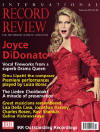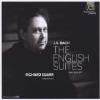Texte paru dans: / Appeared in:
*

International Record Review - (02/2013)
Pour
s'abonner / Subscription information
Harmonia Mundi
HMU907591.92

0093046759124 (ID289)
There is of course nothing particularly ‘English’ about these suites. Even if the probably apocryphal anecdote of their having been commissioned for an English nobleman were true it would change nothing concerning their musical material: six ‘Suittes avec leurs Préludes’ entitled in French and in the classic Franco-German style. They all follow a similar pattern, with a Prélude (becoming more and more substantial through the collection — the Prélude to the Sixth Suite lasts a full five minutes) preceding an Allemande, a Courante and a Sarabande; ending with a Gigue and with a Bourrée, Menuet, Gavotte or Passepied in fifth position supplying a little popular character.
Richard Egarr dates the suites to somewhere between 1717 and 1723; one may read elsewhere that they stem from Bach’s early years in Weimar. (The occasional wildness of the chromaticisms and modulations certainly points in the Weimar direction, as does the occasional unconventionality of structure — the impeccable balance of the later J. S. Bach seems a little way off yet.) The individual dance types are clearly standardized in their characteristic gestures: the Allemandes and Courantes start with upbeats in the treble, the Gavottes employ a musette-like drone, the Courantes cadence with a consistent formula (and Egarr employs a consistent ornamentation for good measure).
Egarr’s way with Bach is by now probably well known to most listeners. (He has had the good fortune over the last few years to enjoy the steady support of a single label. A rare thing nowadays for a harpsichordist - indeed for any performer.) His recent Bach recordings have made a brilliantly effective case for the use of an unequal temperament in Bach’s music (above all his Well- Tempered Clavier, Book 1 , also for Harmonia Mundi, making use of a tuning deduced from the manuscript title page by Bradley Lehman). Here he uses a tuning system of his own devising and again it serves him (and Bach) extremely well. Even if the individual suites remain in a single key, thus minimizing contrasts between adjacent movements, the progression across the suites from the astringent brightness (in this tuning) of A major to the solemn fullness of D minor provides an effective backbone for the collection as a whole (the tonic notes of the six suites spell out the first phrase of the chorale melody Jesu, meine Freude, which even if it were a coincidence is unlikely to have escaped Bach’s attention) — and Bach’s sometimes adventurous modulations are all the more effective when each key has its own distinct flavour. (The Sarabande of the G minor Suite at one point reaches an imperfect cadence as far afield as A flat minor; the E minor Suite frequently dwells on extremely tangy B major chords at its cadences.)
Egarr does not shy away from generously ornamenting Bach’s text on repeats. In the two Sarabandes where Bach left separate ornamented versions (‘Les agréments de la même Sarabande’), Egarr plays these in addition to his own. This is perhaps not the only possible solution but it is not too disturbingly redundant — it is quite normal in the suite tradition for dances to be supplemented by an ornamented Double. His registrations are predominantly full; in the major-key section of the final Gavotte, however, he leaves the melody poignantly to the four-foot register alone. The recorded sound is full and intimate, providing a distinctly immersive experience in the frequent excursions into the harpsichord’s bass register (the suites frequently descend to the A three leger lines below the bass stave). Egarr remains true here to the predominantly cantabile style of his previous Bach releases, employing clipped staccatos and percussive attacks only occasionally for special effect: in the repeated chords of the G minor Suite’s somewhat Scarlattian Prélude, for example, or in a few rather thwacky low Es in the Prélude to the A minor Suite. He is an all the more eloquent guide for being a relatively unshowy one, his continuously supple rubato aptly realizing Bach’s harmonic twists without resort to undue histrionics.
This is yet another fine release from one of the most
consistently stimulating keyboard artists recording today.
Fermer la fenêtre/Close window
Cliquez l'un ou l'autre
bouton pour découvrir bien d'autres critiques de CD
Click either button for many other reviews


